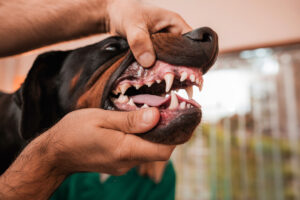As our February Dental month approaches, it is important to remember our pets’ genetic history, especially when it comes to their oral hygiene. Our beloved dogs and cats are descendants of wild breeds that didn’t always behave like our domesticated companions. Despite their current domesticated and cuddly demeanor, our furry family members can still display some evolutionarily-inherent traits that might mask the need for necessary oral care.

Have you ever found yourself chewing on one side of your mouth for weeks or months on end simply to avoid going to the dentist and getting that pesky cavity filled? Chances are, if you have ever had a toothache, cavity, or similar oral discomfort, you may have tried to soldier on for a time and ignore the discomfort. It’s not a bad thing; it simply means you’re human. In fact, this behavior – attempting to hide pain or weakness – may very well be a genetically inherited predisposition from our ancestors, whose survival may very well have depended on a certain level of toughness and resolve. https://www.psychologytoday.com/blog/canine-corner/201109/do-dogs-feel-pain-the-same-way-humans-do
While these kinds of traits may vary from person to person, the genetically inherited instinct to mask or hide weakness and pain is a serious reality for our dogs and cats. Our canine and feline companions – despite years of increasingly domesticated evolution – are still genetically hardwired to hide pain and discomfort. It is simply an innate survival instinct, borne from their more wild ancestors. While they may not be able to hide a limp as easily, our dogs and cats will continue to look and sound as happy as ever despite serious discomfort or pain in their mouths. So often, clients will come in for their regular vet check up and fail to notice anything wrong with their pet’s mouth, like an abscessed tooth, bleeding gums, or even later-stage periodontal disease.
It is because of this genetically-inherited behavior that annual dental check-ups are so vital to the long term health of your furry family members. With a full oral examination, your vet will be able to identify any possible symptoms your pet may be trying to hide. But do not fear! If you know what to look for, there are some other, more subtle signs that your pet may be experiencing some oral pain or discomfort and might need an oral exam from your vet. Behavior like dropping food while chewing, drooling, picky or finicky eating habits, and actively chewing on one side of their mouth could all be possible signs of dental problems. If your pet displays any of these telltale signs, you should definitely call and schedule an oral exam with your vet.
All of this may feel a little overwhelming, but the good news is that the vast majority of canine and feline dental problems are easily avoidable. Regular, annual preventative dental care – including annual oral check ups – are far more cost effective and patient friendly in the long run. You should think of your pet’s mouth and teeth just like you would your own mouth and teeth. Regular, habitual care is always the safest and soundest bet!
